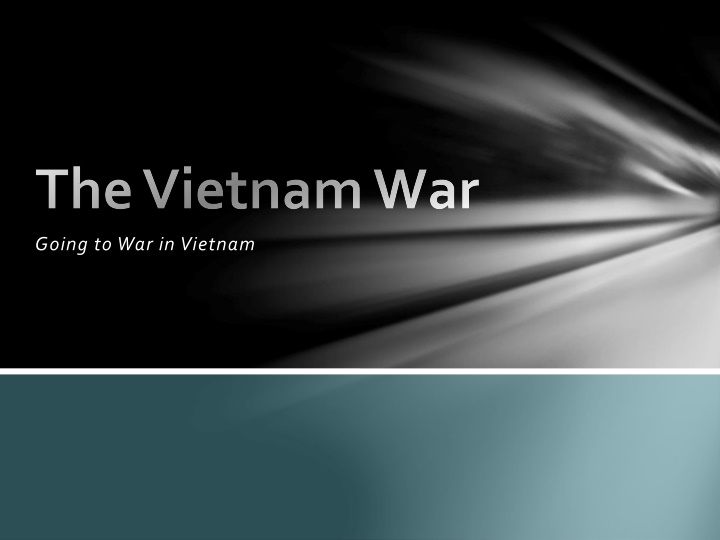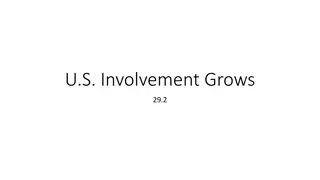The Vietnam War: American Involvement and Escalation
The Vietnam War saw deepening American involvement, from military advisors under Eisenhower to troop deployments and sustained bombing campaigns under Kennedy and Johnson. The conflict escalated with political turmoil in Vietnam, the Gulf of Tonkin Resolution, and the emergence of a bloody stalemate characterized by frustrating warfare tactics on both sides.
Download Presentation

Please find below an Image/Link to download the presentation.
The content on the website is provided AS IS for your information and personal use only. It may not be sold, licensed, or shared on other websites without obtaining consent from the author.If you encounter any issues during the download, it is possible that the publisher has removed the file from their server.
You are allowed to download the files provided on this website for personal or commercial use, subject to the condition that they are used lawfully. All files are the property of their respective owners.
The content on the website is provided AS IS for your information and personal use only. It may not be sold, licensed, or shared on other websites without obtaining consent from the author.
E N D
Presentation Transcript
The Vietnam War Going to War in Vietnam
American Involvement Deepens Ho Chi Minh and his followers began an armed struggle to reunify the nation. They organized a new guerrilla army, which became known as the Vietcong. President Eisenhower increased American aid, and sent hundreds of military advisers to train South Vietnam s army. The Vietcong continued to grow more powerful, in part because many Vietnamese opposed Diem s government, and in part because of the Vietcong's use of terror.
American Involvement Deepens Kennedy Takes over Takes office in 1961, Kennedy continues the nation s policy of support for South Vietnam. Kennedy needed to appear tough on communism, since Republicans often accused Democrats of having lost China to communism during the Truman administration. American officials believe the Vietcong continued to grow because Diem s government was unpopular and corrupt. The South Vietnamese created special fortified villages, known as strategic hamlets.
American Involvement Deepens The Overthrow of Diem Diem, a Catholic, banned the traditional religious flags for Buddha's birthday. When Buddhists took to the streets in protest, Diem s police killed 9 people and injured 14 others. In the demonstrations that followed, a Buddhist monk set himself on fire, the first of several to do so. Generals launched a military coup. They seized power on November 1st, 1963, and executed Diem shortly afterward.
Johnson and Vietnam The Gulf of Tonkin Resolution On August 2,1964, President Johnson announces that North Vietnamese torpedo boats had fired on two American destroyers in the gulf of Tonkin. Johnson asks Congress to authorize the use of force to defend American forces. Gulf of Tonkin Resolution Congress had, in effect, handed its war powers over to the president.
Johnson and Vietnam The United States Sends in Troops The Vietcong begins to attack bases where American advisers stationed in South Vietnam. After the airstrikes, one poll showed that Johnson s approval rating on his handling of Vietnam jumped from 41 percent to 60 percent. In March 1965, Johnson expanded American involvement by shifting his policy to a sustained bombing campaign against North Vietnam. The campaign was named Operation Rolling Thunder.
A Bloody Stalemate Emerges Frustrating Warfare American forces also sought to take away the Vietcong s ability to hide in the thick jungles by literally destroying the landscape. Napalm, a jellied gasoline that explodes on contact. Agent Orange, a chemical that strips leaves from trees and shrubs, turning farmland and forest into wasteland.
A Bloody Stalemate Emerges A Determined Enemy Ho Chi Minh trail. Because the trail passed through countries not directly involved in the war, President Johnsonrefused to allow a full scale attack on the trail shut it down. President Johnson refused to order a full-scale invasion of North Vietnam He feared that such an attack would bring China into the war. A war of attrition-a strategy of defeating the enemy forces by slowly wearing them down.
Essay Question Describe the Vietcong s battle tactics and ways that American troops tried to counter these tactics.
Essay Question and Answer Describe the Vietcong s battle tactics and ways that American troops tried to counter these tactics. Lacking the firepower of the Americans, the Vietcong used ambushes, booby traps, and hit-and-run tactics. The Vietcong also frustrated American troops by blending in with the general population in the cities and the countryside and then quickly vanishing. As one journalist put it, It s a war where nothing is ever quite certain and nowhere is ever quite safe. To counter the enemy s tactics, American troops went on search-and-destroy missions. They tried to find enemy troops, bomb their positions, destroy their supply lines, and force them out into the open for combat. American forces also sought to take away Vietcong's ability to hide in the thick jungles by literally destroying the landscape. American planes dropped napalm and Agent Orange, a chemical that strips leaves from trees and shrubs, turning the farmland and forest into wasteland.























